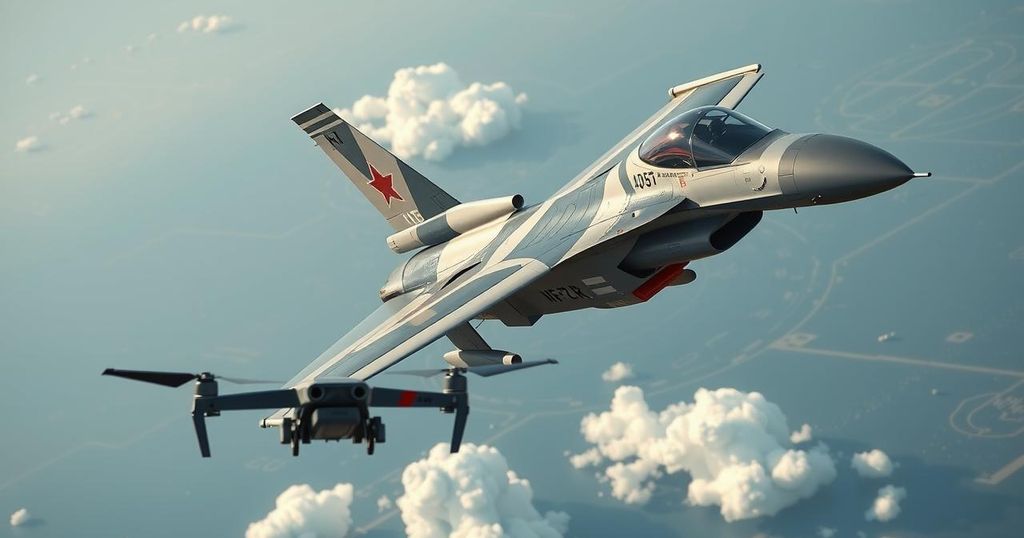Escalating NATO Tensions: The U.S. and Turkey’s Complicated Conflict in Syria

Heightened tensions in Syria suggest a looming conflict between NATO allies the U.S. and Turkey, evidenced by the SDF’s downing of Turkish drones and an October incident involving a U.S. F-16. The SDF has effectively countered Turkish drone operations, indicating a significant shift in regional dynamics, all against the backdrop of a fragile ceasefire and U.S. military deployment.
The geopolitical landscape in Syria is increasingly characterized by tensions between NATO allies, particularly the United States and Turkey. This situation escalated when the Syrian Democratic Forces (SDF) recently announced the successful downing of a Turkish Bayraktar TB2 drone near the Karakozak Bridge in Raqqa. This incident, along with previous similar occurrences, underscores the rising effectiveness of the SDF in countering Turkish drone operations. The implications of these actions could signify a troubling trend towards direct conflict between NATO members in the region.
The SDF has actively targeted Turkish drones, asserting their capability to neutralize advanced technology. In fact, they reported the downing of three Turkish drones in the preceding month. The latest incident occurred on January 1, 2025, when the SDF stated, “At exactly 1:00 PM this afternoon, our fighters successfully downed a Turkish Bayraktar TB2 drone in the Karakozak Bridge area.” This showcases the growing power of the SDF in the ongoing conflict and the potential for a significant escalation of hostilities.
Further compounding these tensions was an October 2023 episode when a U.S. Air Force F-16 shot down a Turkish drone that posed a risk to American forces. The drone, thought to be targeting Kurdish YPG fighters, prompted a rare and consequential engagement between NATO allies. Despite Turkish authorities denying ownership of the drone, this incident highlights the fragile nature of alliances within NATO alongside heightened regional conflicts.
The U.S. has taken on a complex mediating role in these disputes, attempting to uphold ceasefire agreements in areas such as Manbij. Despite the U.S. Department of Defense’s continuous confirmation of ceasefire status, remarks from the SDF accusing Turkey of escalating aggression reflect an ongoing conflict dynamic. SDF representatives criticized continued Turkish involvement, stating, “the Turkish state and its proxies are escalating their aggression while disregarding all de-escalation efforts.”
Lastly, reports indicate a potential strategic shift regarding U.S. military operations in northern Syria, with indications of increased troop presence near Kobani. This move suggests a proactive American stance amidst the rising conflict, despite the primary focus on ISIS.
The situation in Syria remains precarious as increasing confrontations between U.S.-backed forces and Turkey’s military could lead to a NATO friction point. The capability of the SDF to challenge Turkish aerial superiority marks a significant shift in the balance of power in the region and threatens to complicate the U.S. approach toward its allies, while simultaneous efforts to combat terrorist groups in Syria must not be overlooked. As these tensions unfold, the international community watches closely to understand whether this conflict might evolve into a larger confrontation between allied powers.
The ongoing civil conflict in Syria has seen varied involvement from global powers, notably the NATO alliance, which includes both the United States and Turkey. Divergent interests between these two nations have been particularly highlighted in their relations with the Syrian Democratic Forces, an alliance primarily composed of Kurdish elements once recognized as crucial partners in battling ISIS. As Turkey regards the SDF as a terrorist group, tensions from failed ceasefires and military confrontations have surged, leading to a potential NATO conflict.
In summary, escalating confrontations between U.S.-backed forces and Turkey highlight an emerging conflict within NATO, driven by competing national interests in Syria. Incidents like the downing of Turkish drones by the SDF exemplify a profound shift in military dynamics, while the U.S.’s expanding military presence suggests a strategic recalibration in response to regional tensions. The delicate balance of alliances within NATO is increasingly tested as these geopolitical complexities evolve.
Original Source: www.india.com








